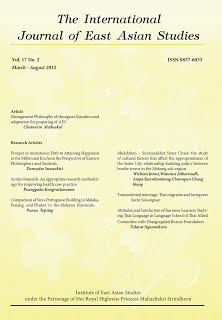Comparison of Sino-Portuguese Building in Malaka, Penang, and Phuket in the Malayan Peninsula
Keywords:
Comparison, Sino-Portuguese, Malayan PeninsulaAbstract
This article aims to study the comparison traditional building of commonly referred “Sino-Portuguese” style in Malaka, Penang ,and Phuket by studying the sample buildings in each places, and use the comparative analysis in 3 issues, which are: 1) Name of building; 2) Origin of building; 3) Characteristic of building facadeThe study found that the term “Sino-Portuguese” was normally used in referral to the colonial buildings in Thailand, but in Malaysia especially in Malaka and Penang These buildings would called by other names. In term of the origin of buildings, it was found that western arts had influenced to the building in both of Malaka Penang as well as Phuket. Malaka was the first place to adopt western arts which then spread to spread to Penang and Phuket respectively. In Malaka, most of the buildings were of Baroque, Rococo, and Islamic styles. In Penang, most of the buildings were of the Neo-classic. future more, during the nineteenth century, due to the spread of Eclecticism in Penang, the arts of the western, Chinese, India and Local Malayu peoples in Penang were blended into a new style, identical to that in Phuket. The characteristic of the buildings in Phuket was that of row buildings or “shop houses” with narrow width front. The early period building had a door in the middle of building, and braced with window. The later period building would have open-spaced lower floor for conducting business. The component of building had been set divisibly, and there were footpaths underneath the buildings. In Malaka, the Chinese influence was strong, but dwindled in Penang and Phuket.
Downloads
Download data is not yet available.
Downloads
Published
2012-09-30
How to Cite
Tepsing, P. (2012). Comparison of Sino-Portuguese Building in Malaka, Penang, and Phuket in the Malayan Peninsula. Thai Journal of East Asian Studies, 17(2), 37–49. retrieved from https://so02.tci-thaijo.org/index.php/easttu/article/view/50679
Issue
Section
Research Articles



